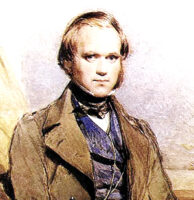 Inheritance carries evolution forward, theoretically, and is the second topic in the V.I.S.T.A. acronym (Variation, Inheritance, Selection, Time, Adaptation) developed by Niles Eldredge of the American Museum of Natural History to describe the mechanisms of Charles Darwin’s theory – the second of the five pillars of natural selection. In 1837, Darwin drew his first tree of life sketch (pictured left), nearly twenty years before the Origin of Species.
Inheritance carries evolution forward, theoretically, and is the second topic in the V.I.S.T.A. acronym (Variation, Inheritance, Selection, Time, Adaptation) developed by Niles Eldredge of the American Museum of Natural History to describe the mechanisms of Charles Darwin’s theory – the second of the five pillars of natural selection. In 1837, Darwin drew his first tree of life sketch (pictured left), nearly twenty years before the Origin of Species.
Knowing Darwin’s mechanisms of inheritance is essential for understanding his theory since inheritance plays a “chief part” in natural selection. As Darwin explains in the Origin of Species –
“The most important consideration is that the chief part of the organisation of every being is simply due to inheritance.”
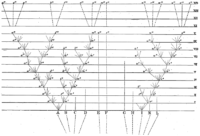
Inheritance is the biological process of transferring information from one generation to the next. In the only diagram in the Origin of Species, Darwin illustrates how his theory of inheritance carries evolution forward from generation to generation. Of the original eleven species (A – L), the specie noted as (I) evolved into six distinct species over fourteen generations. As described (page 94) by Darwin –
“The six descendants from (I) will form two sub-genera or genera… the six descendants from (I) will, owing to inheritance alone.”
The six species evolving from specie I over fourteen generations on the diagram are expressed as n14, p14, w14, y14, u14, and z14. – “owing to inheritance.” Darwin notes that each horizontal line in the diagram “may represent each a thousand or more generations… up to the fourteen-thousandth generation.”
However, Darwin’s inheritance theory in the Origin of Species never gained wide acceptance by naturalists, even in the nineteenth century. This article retraces the rise and fall of Darwin’s inheritance theory, driven by blending inheritance and pangenesis through particles he called gemmules.
Inheritance Theory Development
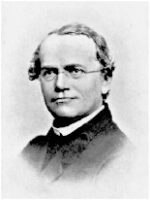 Darwin developed his inheritance theory based on a belief – without empirical evidence, unlike Gregor Mendel (pictured left), who studied nearly 300,000 pea plant observations empirically.
Darwin developed his inheritance theory based on a belief – without empirical evidence, unlike Gregor Mendel (pictured left), who studied nearly 300,000 pea plant observations empirically.
During the nineteenth century, in alignment with the increasingly popular progressive movement known as the Age of Enlightenment, many naturalists connected with the trend to abandon the scientific method, including Darwin. As Darwin explains (page 93), his inheritance theory, starting from the original “A” specie –
“By continuing the same process for a greater number of generations (as shown in the diagram in a condensed and simplified manner), we get eight species, marked by the letters between a14 and m14, all descended from (A). Thus, as I believe, species are multiplied and genera are formed.”
Darwin’s “I believe” approach directed the development of his theory. By the eleventh generation, all the original eleven species became extinct except for three – A, F, and I; with species F never evolving. By the fourteenth generation, Darwin depicted fifteen species resulting in a net gain of four species.
The answer to the question of what data Darwin used is none. The diagram was pure speculation, unsupported by objective empiric observations; preconceived beliefs drove his theory. To emphasize his “I believe” approach, Darwin noted (p. 424) again –
“I believe that animals are descended from at most only four or five progenitors, and plants from an equal or lesser number.”
Interestingly, “inheritance” was never defined by Darwin in any of the six editions of the Origin of Species, nor were any scientific terms, for good reasons – vague terms are not falsifiable. This reasoning approach, formalized by French philosopher Rene Descartes, reflects the three principles of the Enlightenment movement.
In the Origin of Species, Darwin described his mechanism of inheritance as a blending process. However, as will be discussed, Darwin would later envision inheritance as a process of pangenesis driven by particles of acquired characteristics called gemmules in his books, best known as Variation Under Domestication.
Blending Inheritance 
Blending was the predominant theory of inheritance during the nineteenth century – known as blending inheritance. Darwin (pictured right) refers to blending in the Origin of Species twenty times. However, Darwin never used the term “blending inheritance.”
In blending inheritance, parenteral characteristics in the offspring would be intermediate between the two parents. For example, crossing a red-flower parent with a white-flower parent would produce a pink-flowered offspring.
Darwin was skeptical of blending inheritance, especially since inheritance must carry evolutionary changes forward. In the Origin of Species, Darwin illustrates why –
“If you cross two exceedingly close races or two slightly different individuals of the same race, then, in fact, you annul and obliterate the differences.”
Ultimately, blending inheritance would result in homogenized populations of intermediate characteristics incapable of carrying evolution forward. As a skeptic of blending inheritance’s current popularity, Darwin avoided the issue in the Origin of Species by noting –
“The laws governing inheritance are, for the most part, unknown.”
Gregor Mendel, a contemporary of Darwin, falsified the theory of blending inheritance using pea plants by demonstrating genetic traits to be discrete and independent – not blended. Blending inheritance is now regarded as an “obsolete theory in biology.”
Darwin’s Pangenesis
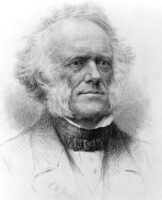 Nine years following the 1859 publication of the Origin of Species, Darwin finally published his theory of inheritance book entitled The Variation of Animals and Plants Under Domestication in 1868 – a theory he called pangenesis. Darwin’s model, however, was quickly recognized as a disguised version of blending inheritance.
Nine years following the 1859 publication of the Origin of Species, Darwin finally published his theory of inheritance book entitled The Variation of Animals and Plants Under Domestication in 1868 – a theory he called pangenesis. Darwin’s model, however, was quickly recognized as a disguised version of blending inheritance.
For his theory, Darwin introduced the concept of gemmules as the physical conveyors of inheritance that act as acquired characteristics. Using the term over 150 times in Variation Under Domestication, the shortened name of his inheritance book, Darwin explains the role of gemmules –
The hypothesis of Pangenesis, as applied to the several great classes of facts just discussed, no doubt is extremely complex, but so are the facts. The chief assumption is that all the units of the body, besides having the universally admitted power of growing by self-division, throw off minute gemmules which are dispersed through the system… capable of transmission in a dormant state, like seeds in the ground, to successive generations.”
Seven years later, in 1875, Darwin published the second edition of this two-volume set. As described in a twenty-first-century synopsis –
“Pangenesis was Charles Darwin’s hypothetical mechanism for heredity, in which he proposed that each part of the body continually emitted its own type of small organic particles called gemmules that aggregated in the gonads, contributing heritable information to the gametes.”
However, pangenesis generated even more questions than answers. Several critics also noticed that Darwin’s theory was essentially a reversion of Jean-Baptiste Lamarck’s blending inheritance theory of acquired characteristics, including Charles Lyell (pictured left), his closest colleague. In an attempt to distance himself from Lamarck, Darwin wrote a rather curt letter to Lyell –
“You refer repeatedly to my view as a modification of Lamarck’s doctrine of development & progression; if this is your deliberate opinion, there is nothing to be said—; but… I can see nothing else in common between the Origin & Lamarck.”
After seven years of work, even Darwin’s skepticism continued, given the criticisms and the seemingly “insurmountable” issues. In the concluding chapter of Variation Under Domestication, Darwin hedgingly waved a white flag –
“The hypothesis of Pangenesis, as applied to the several great classes of facts just discussed, no doubt is extremely complex; but so assuredly are the facts… The difficulty, therefore, which at first appears insurmountable, of believing in the existence of gemmules so numerous and small as they must be according to our hypothesis, has no great weight.”
The ultimate “difficulty” with pangenesis eventually proved to be a “great weight” – and failed to explain how inheritance integrates into his theory of natural selection. As Darwin lamented in his Autobiography –
“My ‘Variation of Animals and Plants under Domestication [Variation Under Domestication]’ was begun, as already stated, in the beginning of 1860, but was not published until the beginning of 1868. It was a big book, and cost me four years and two months’ hard labour… In the second volume the causes and laws of variation, inheritance, &c., are discussed as far as our present state of knowledge permits. Towards the end of the work I give my well-abused hypothesis of Pangenesis.”
Pangenesis Scientifically Tested
Evaluating a theory is a cornerstone component of the scientific method. Francis Galton (pictured right), a British scientist knighted by the King and Darwin’s half-cousin, coordinated with Darwin to perform a series of blood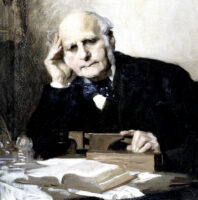 transfusions in different colored rabbits to test Darwin’s pangenesis theory scientifically.
transfusions in different colored rabbits to test Darwin’s pangenesis theory scientifically.
If pangenesis were true, the infusion of blood from a white-colored rabbit, when infused into a black-colored rabbit, would influence the color of the offspring due to the gemmules. In March 1871, Galton read his test results to the Royal Society and later published these in the Proceedings of the Royal Society entitled “Experiments in Pangenesis, by Breeding from Rabbits.”
However, contrary to expectations, the black rabbits with white rabbits’ blood produced black offspring. Galton concluded gemmules do not exist, undermining Darwin’s theory of pangenesis. In his detailed sixteen-page report, Galton concluded –
“I have now made experiments of transfusion and cross circulation on a large scale in rabbits, and have arrived at definite results, negativing, in my opinion, beyond all doubt the truth of the doctrine of Pangenesis.”
In response to Galton’s conclusions, Darwin sent a letter in April 1871 to the Proceedings, noting that gemmules may have been in other bodily fluids and that he never inferred that blood contains gemmules. However, conceding to Galton’s conclusions, Darwin hedged –
“As it is, I think everyone will admit that his experiments are extremely curious and that he deserves the highest credit for his ingenuity and perseverance. But it does not appear to me that Pangenesis has, as yet, received its death blow; though from presenting so many vulnerable points, its life is always in jeopardy, and this is my excuse for having said a few words in its defense.”
Interestingly, the second edition of Variation Under Domestication preceded Darwin’s final two editions of the Origin of Species in 1869 and 1872, respectively. However, pangenesis, “pan-” meaning whole and “genesis” indicating origin, and gemmules never appeared even in these final editions of the Origin of Species.
In 1892, August Weismann, a German evolutionary biologist, extended the demise of Darwin’s pangenesis theory. After removing the tails of 68 white mice over five generations, none of the mice developed any acquired inheritance characteristics, as Darwin predicted. The effect became known as the Weismann Barrier.
The short answer to what scientific evidence validated Darwin’s pangenesis theory is “none.” The Evolution 101 website, sponsored by the University of California, Berkeley, concurs –
“Darwin himself proposed that each cell in an animal’s body released tiny particles [gemmules] that streamed to the sexual organs, where they combined into eggs or sperm. They would then blend together when the animal mated. But “pangenesis,” as Darwin called it, didn’t hold up to scrutiny.”
A Plagiarized Theory
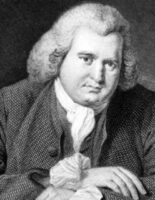 The essence of Darwin’s pangenesis theory was well-known in the nineteenth century by the academic elite, with its origins traceable to Greek philosophy. Yet, Darwin publicly denied any foreknowledge even though his grandfather, Erasmus Darwin (pictured left), argued for pangenesis in Zoonomia –
The essence of Darwin’s pangenesis theory was well-known in the nineteenth century by the academic elite, with its origins traceable to Greek philosophy. Yet, Darwin publicly denied any foreknowledge even though his grandfather, Erasmus Darwin (pictured left), argued for pangenesis in Zoonomia –
“All animals undergo perpetual transformations, which are in part produced by their own exertions… and many of these acquired forms or propensities [acquired characteristics] are transmitted to their posterity [future generations].”
While Erasmus called inheritable “transformations” a product of “their own exertions,” these are what Darwin called gemmules. As WIKIPEDIA explains –
“In 1801, Erasmus Darwin advocated a hypothesis of pangenesis in the third edition of his book Zoonomia.“
In the month following the publication of Variation Under Domestication, Darwin responded to a presumed now-lost letter from William Ogle, an English physician fluent in classical Greek. In his reply, wishing he had known about pangenesis earlier, Darwin wrote –
“I thank you most sincerely for your letter which is very interesting to me. I wish I had known of these views of Hippocrates (pictured right), before I had published, for they seem almost identical with mine—merely a change of terms—& an application of them to classes of facts necessarily unknown to this old philosopher. The whole case is a good illustration of how rarely anything is new.— The notion of pangenesis has been a wonderful relief to my mind, (as it has to some few others) for during long years I could not conceive any possible explanation of inheritance.”
terms—& an application of them to classes of facts necessarily unknown to this old philosopher. The whole case is a good illustration of how rarely anything is new.— The notion of pangenesis has been a wonderful relief to my mind, (as it has to some few others) for during long years I could not conceive any possible explanation of inheritance.”
However, Conway Zirkle, historian of science at the University of Pennsylvania, considers Darwin’s “wish” a fabrication. In his article “The Inheritance of Acquired Characteristics and the Provisional Hypothesis of Pangenesis” in the American Naturalist, published in 1935, Zirkle explains –
“The hypothesis of pangenesis is as old as the belief in the inheritance of acquired characters. It was endorsed by Hippocrates, Democritus, Galen, Clement of Alexandria, Lactantius, St. Isidore of Seville, Bartholomeus Anglicus, St. Albert the Great, St. Thomas of Aquinas, Peter of Crescentius, Paracelsus, Jerome Cardan, Levinus Lemnius, Venette, John Ray, Buffon, Bonnet, Maupertuis, von Haller, and Herbert Spencer.”
Without an operational theory of inheritance, the influence of Darwin’s theory increasingly waned during the late nineteenth century. However, the rediscovery of Mendel’s theory of inheritance by German geneticist Carl Correns re-ignited interest in Darwin’s theory of natural selection at the turn of the century.
Genesis
 The legacy of inheritance by Darwin belongs in the halls of history but not in science classes. The twentieth-century genomic revolution rescued Darwin’s theory of natural selection, armed with a new theory of inheritance – the modern synthesis theory.
The legacy of inheritance by Darwin belongs in the halls of history but not in science classes. The twentieth-century genomic revolution rescued Darwin’s theory of natural selection, armed with a new theory of inheritance – the modern synthesis theory.
Since then, biotechnology has discovered that the modern synthesis theory fails to account for observed inheritance seemingly unrelated to genetic coding.
While the Genesis account written by Moses is compatible with scientific evidence, nature operates by mysteries that seemingly defy a scientifically valid explanation. As founder of the Scientific Revolution, Francis Bacon, a pioneer of the scientific method, explains –
“God of heaven and earth had vouchsafed the grace to know the works of Creation… to discern between divine miracles, works of nature, [and] works of art.”
Refer to the Glossary for the definition of terms and to Understanding Evolution for insights into how and why the investigative approach to examining the validity of evolution often results in vastly different conclusions.
V.I.S.T.A. Links
Inheritance carries evolution forward, theoretically, and is the second topic in the V.I.S.T.A. acronym developed by Niles Eldredge of the American Museum of Natural History to describe Charles Darwin’s mechanisms of evolution.
The V.I.S.T.A. acronym represents the five major topics of Darwin’s theory: variation (V), inheritance (I), selection (S), time (T), and adaptation (A). Explore Darwin’s original theory and how scientific evidence has prompted changes to his concepts since the publication of the last edition of the Origin of Species in 1872 using the following links ––
V – Variation – Variations Drive Evolution
I – Inheritance
-
-
-
- Inheritance by Darwin – (current page)
- Mendel Rescued Darwin-To a Point
-
-
S – Selection – (under construction)
T – Time – (under construction)
A – Adaptation – (under construction)

